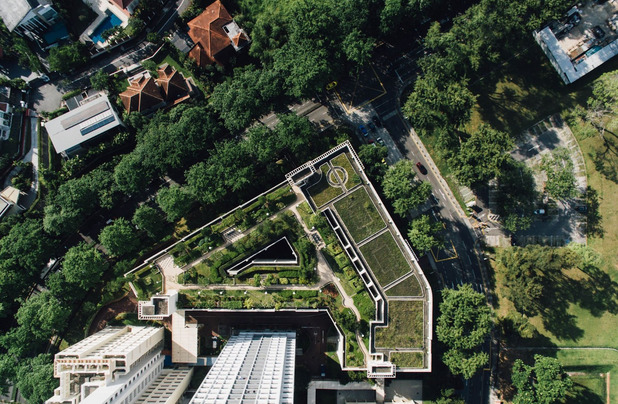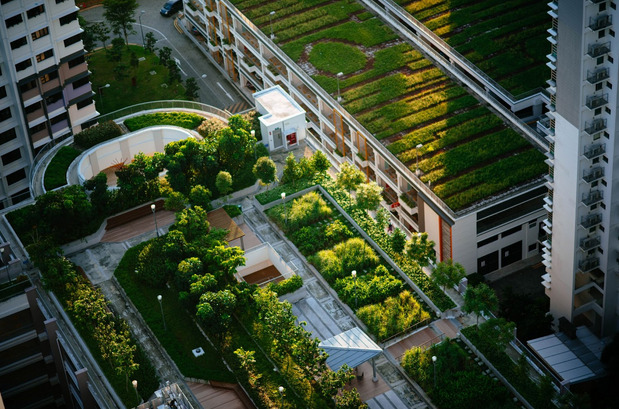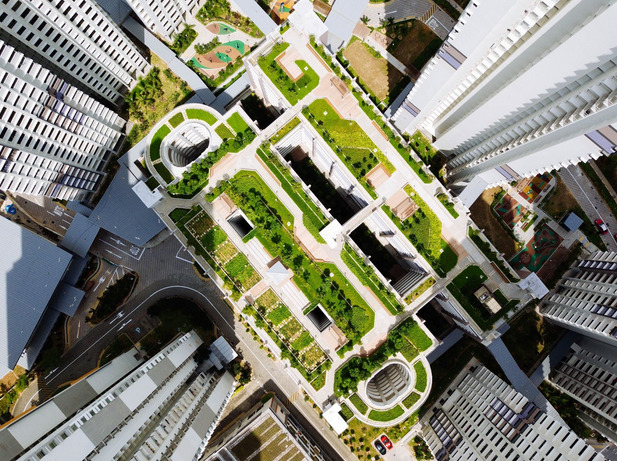Hint: Like our Designs, They’re So Much More than a Pretty Space

The past few years have brought radical rethinking of how we live and work, including how we use our spaces. With outdoor spaces taking on a previously-unimagined level of importance for businesses and homeowners, more and more building owners are installing green roofing systems with far reaching benefits.
As an amenity, green roofs are also one of the most popular commercial office design ideas, since they provide a host of benefits for well-being, in addition to aesthetic and environmental benefits that make them a high-value project on many levels.
The obvious benefit of having a beautiful, functional space among nature is surprisingly just the tip of the iceberg.
Read on to discover more details about the benefits of green roofing in commercial and residential design.
Energy Efficiency
Living roofs have many beneficial energy efficiency features. The insulative properties of the base membrane, combined with the soil layer and plantings, help give green roofs a higher r-value than many other roofing products. When used as part of a continuous insulation system for a building, living roofs can significantly help reduce heating and cooling costs and energy consumption.
Sound Insulation
Stormwater Management & Erosion Control

While many roofing systems praise their impermeable properties, a living roof is the only type that reduces runoff that can create erosion concerns in times of heavy precipitation.
Therefore, a flat roof system can help quell unwanted runoff by effectively using stormwater as part of its natural ecosystem, with the soil retaining a portion of the water. When the precipitation becomes too intense, effectively placed landscape drains can help mitigate the excess flow and direct the water to a more desirable location.
Replenishes Food and Habitat Resources
Perhaps the most devastating effect of suburban sprawl is that not only does construction require the consumption of natural resources, but the construction sites themselves displace habitat that feeds and protects the pollinators and all other members of the natural world.
The installation of a green roof for your flat roof system makes it possible to replenish part of what the building has taken away from the natural environment. Plants and shrubbery on a living roof can serve as hosts for a wide variety of organisms necessary for maintaining a healthy ecosystem.
Furthermore, some of the more innovative living roofs use the space for urban gardening. As urban areas consume many food products that require significant transportation resources to import from rural areas, this is a great way for keeping food consumption as local as possible.
Filters Pollutants and Carbon Dioxide Emissions

In addition to some of the sustainability examples listed previously, the consumption of carbon dioxide by trees and other plantings is another positive environmental impact of green roofs. The average tree will consume about 48 pounds of carbon dioxide in a year, which will equate to roughly one ton of carbon dioxide consumed by the time it reaches 40. Although we need to eradicate the effect of the 43 billion pounds of carbon dioxide released each year, green roofs on our enormous inventory of buildings are definitely part of the solution for helping slow the effects of climate change.
Long-Term Economic Benefits
While the most elaborate living roof replacements can cost as much as $200 per square foot, more often they range from $10-50 per square foot and utilize self-sustaining, drought-tolerant native plantings that require little care beyond occasional weeding.
However, as with anything in the design and renovation sphere, initial costs need to be analyzed from the proper perspective.
Due to the outstanding insulation of a green roof, many of the upfront costs of installation will be recovered via lower utility bills, and a green roof, when well-maintained, will extend the life of the roof by 300%. A living roof will not wear out and degrade at the same rate as cheaper roofing options, helping the building achieve lower maintenance and repair costs over time.
Functional Space for Outdoor Enjoyment
The COVID-19 pandemic brought air quality and social distancing into the forefront of the national consciousness. This left many businesses scrambling to convert breezeways and patios into flex workspaces.
With this in mind, any flat roof facility would do well to use a living roof as a way for employees to get some open air space. With the proper shading devices, rooftop views would give tenants an unmatched change of scenery to get some work done or simply enjoy their lunch.
Less Reliance on Processed Materials

Many common roofing products require significant resources during fabrication. For example, asphalt shingles are typically made from some type of petroleum residue, while wood shakes require harvesting and treating timber.
Although living roofs do require a waterproof membrane to be laid prior to installation, typically made from some type of thermoplastic PVC, they are the epitome of a natural roofing solution. Outside of the membrane, they require no refinement in a plant to convert to a usable product, and will not require additional consumption of milled or processed materials for maintenance and repair.
Get Creative to Enjoy the Many Benefits of Green Roofing
Of all the design trends to take center stage in 2022, one of the most stunning, yet highly functional, is the increased interest in green roofing. From outstanding insulation to stormwater management and elite erosion control, long-term economic benefits of improved energy efficiency and roof longevity, there are numerous reasons to go green as a flat roof solution this year!
Natalie Akins is an editor for the Innovative Building Materials blog and a content writer for the building materials industry. She is focused on helping fellow homeowners, contractors, designers and architects discover materials and methods of construction that save money, improve energy efficiency, and increase property value.
